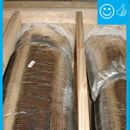Flex duct through an air barrier
Greetings,
In reference to maintaining the integrity of an air barrier, best practice requires all penetrations be properly sealed. Of course the most prevalent holes are manufactured by tradespeople, many of whom don’t understand the importance of the endeavor.
Specifically, when HVAC ducts penetrate the air barrier between conditioned and conditioned space, both code and Energy Star requires the annular space between the hole and the duct be air sealed.
Since there is a love affair with flex duct among the HVAC community, most of these penetrations is made with flex duct. And in all cases, I see the air sealing being made around the outer jacket of the duct. The two attached graphics even give a thumbs up on the practice.
Of course if the outer jacket is the air barrier, then why do ADC guidelines require sealing the inner liner to all duct connections? It is my understanding the outer jacket is simply to retard vapor diffusion.
I thought I recall that such penetrations are required to include a metal sleeve through the air barrier with flex connected on each end. Then, the air sealing would be effectively sealing to the air barrier of the duct.
Apparently, I am the only person in the U.S. who ever required this. Am I being just too picky? If the air barrier is also called a draft or fire stop, is it code compliant to seal the outer jacket of the flex duct to meet the fire stop requirement?
GBA Detail Library
A collection of one thousand construction details organized by climate and house part











Replies
Insulated flex duct like this is too “squishy” for anything rigid to make an effective long-term seal. In this case, both caulk and canned foam are “rigidl compared to the duct. Acoustical sealant would be better, but still probably won’t last. A rigid sleeve of regular smooth metal duct sealed to the air barrier with the flex duct attached on both ends would be much better.
I see fire stops done incorrectly all the time. The most common mistake is using a sealant not rated for the purpose, but there are plenty of times something is done that works for a little while but won last.
Bill
You're exactly right Bill. Most of the time I see foam. Sometimes its fire-rated. But usually not.
My dilemma is citing an authority to declare ceiling the outside jacket a failure. Anecdotally, few people would argue its not the best way to seal the penetration.
If you want to get it failed, ask the fire marshall to look at it. The fire guys are usually more careful with the fire stop stuff since they see how important it can be. The next option would be to ask a state inspector instead of your local guys. The state people are usually more competent too. Keep in mind that inviting extra inspectors onto your site may come with unexpected results if they find anything else you weren’t aware of so be careful.
Bill